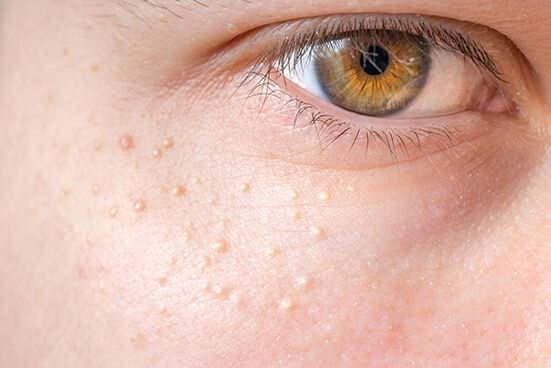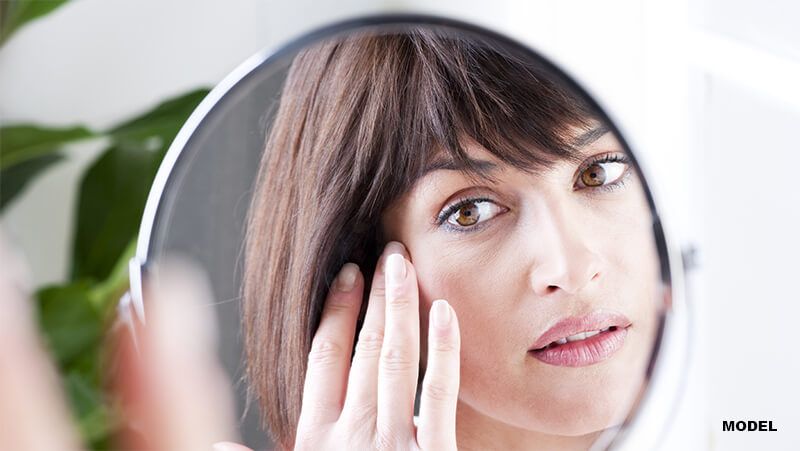Ask A Dermatologist: Milia Symptoms, Causes, and Treatments
What is Milia?
Milia is a common skin condition in which small white bumps, or cysts, appear under the skin. Milia is very common in infants. In fact, roughly 40-50 % of newborn babies have milia. However, newborns are not the only ones who can get milia. In fact, it is common for adults to get milia as well. The most common place for milia to occur on a person’s body is on his or her face. Milia cysts are not harmful and they are not related to other serious diseases such as cancer. Also, although it is sometimes mistaken for acne, milia is not acne. Milia are small cysts that occur when a strong protein called keratin becomes trapped underneath the skin. Milia occur in all ages and sexes, and have no racial predilection.
Are there different types?
Yes, there are a number of different types of milia. The primary types of milia are:
- Neonatal milia – This form of milia affects infants and newborns.
- Primary milia – This type of milia affects both children and adults. Small cysts appear on the forehead, cheeks, eyelids, or genitals.
- Secondary milia (traumatic milia) – Secondary milia is a type of milia in which small cysts appear on the skin after it has been damaged by things like burns, dermabrasion, rashes, blisters, inflammation or other skin trauma, etc.
- Juvenile milia – This is a type of milia in which cysts appear as a result of an inherited condition. Cysts can appear at birth or at a later time.
- Milia en plaque – This type of milia appears more commonly in middle-aged women. For this type of milia, the cysts typically appear on the eyelids, cheek or jaw, or behind the ears. This type of milia can sometimes be associated with other inflammatory skin conditions.
- Multiple eruptive milia – Crops of numerous milia that occur over several weeks or months. With this type of milia cysts appear on the upper abdomen, upper arms, and face and can be itchy.
- Medication induced milia – Milia can rarely form after the application of some topical medications, including steroids, phenol, hydroquinone, and 5-fluorouracil.

An example of milia under the eye
What are the symptoms of Milia?
The most prevalent symptom of milia is white or yellow bumps on the skin. Sometimes the bumps appear in clusters and they do not cause any sort of discomfort or pain. Usually, they do not itch, but with multiple eruptive milia, they can sometimes itch.
Where can Milia occur?
The most common places for milia to occur are the forehead, cheeks, nose, or eyelids. However, milia can also appear on the arms, genitals, chest, or inside of the mouth.
What causes Milia?
When it comes to milia in newborns and infants, it is believed milia may develop secondary to immaturity of the sebaceous glands. When milia occur in adolescents and adults, it is often caused by some sort of trauma to the skin such as burns, rashes, or long-term sun damage.
Who is most susceptible to developing Milia?
Infants and newborns are actually the most likely to develop milia. However, the condition resolves quickly for the vast majority of newborns and infants. But, even though newborns get this condition the most, it is still possible for people of all ages to get this condition.
Can Milia be prevented?
Neonatal milia cannot be prevented. It may be possible to reduce the risk of developing other types of milia by taking good care of your skin. For example, avoiding sunburns and protecting your skin from trauma.
Milia treatment options
Most cases of milia will resolve by themselves without needing any treatment in a few weeks or a few months. This is especially true for neonatal milia. For children, teens, or adults with persistent milia, a simple extraction procedure can be performed by your health care professional. Topical medications like retinoids can also be tried with variable success.
When to see a dermatologist
You should see a dermatologist if your milia fails to resolve on it’s own, and you wish to have it removed for aesthetic reasons.
Many new parents are not expecting to see milia on their baby’s face when he or she is born, and so they might be very concerned at first. However, if you have a newborn with milia, the best thing to do is to just wait it out. It’s important to note that other neonatal skin conditions can present in a similar fashion, so it’s always best to have your health care professional take a look.


After reading this article, I finally understand what those pesky little bumps on my skin are! The various treatment options provided have given me hope in tackling my milia. Thank you for the informative and helpful post, Westlake Dermatology!